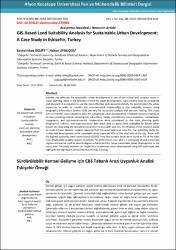| dc.contributor.author | Deliry, Sayed Ishaq | |
| dc.contributor.author | Uyguçgil, Hakan | |
| dc.date.accessioned | 2021-11-01T07:08:28Z | |
| dc.date.available | 2021-11-01T07:08:28Z | |
| dc.date.issued | 25.09.2020 | en_US |
| dc.identifier.citation | Deliry, S. İ. & Uyguçgil, H. (2020). GIS-Based Land Suitability Analysis for Sustainable Urban Development: A Case Study in Eskisehir, Turkey . Afyon Kocatepe Üniversitesi Fen Ve Mühendislik Bilimleri Dergisi , 20 (4) , 634-650 . DOI: 10.35414/akufemubid.679980 | en_US |
| dc.identifier.uri | https://dergipark.org.tr/tr/download/article-file/944051 | |
| dc.identifier.uri | https://doi.org/10.35414/akufemubid.679980 | |
| dc.identifier.uri | https://hdl.handle.net/11630/9606 | |
| dc.description.abstract | Suitable site selection for sustainable urban development is one of the critical and complex issues in
urban planning. Since in the selection of land for urban development, many criteria must be considered
and analyzed, it is required to use the most effective techniques to identify the best location for urban
expansion. In order to consider the environmental sustainability in site suitability analysis, using
Geographic Information System (GIS) can help for successful analysis and decision making. This study
aims to find the most suitable location for sustainable urban development in Eskisehir province based on
six main planning criteria, including ten sub-criteria. Safety, connectivity, socio-economic, compactness,
topography, and eco-environmental conservation were considered as the main planning goals.
Geophysical, cultural, and socio-economic data were used to assess land suitability for future urban
growth by integrating the Analytical Hierarchy Process (AHP) and GIS. The findings of this research based
on multi-criteria decision analysis revealed that the most extensive area has low suitability (44%) for
sustainable development, while unsuitable areas represent 42% of the total area of the city. Areas with
the highest suitability were rarely found (0.01%). Very low suitable lands were found as 7% of the total
area. Moderately suitable regions constitute 7% of the entire area, which is composed of well-connected
regions and can be used as second-degree suitable land for future sustainable urban development in the
study area. The study presents an insight into sustainable urban development using GIS techniques and
highlights the significant constraints that the city is facing. | en_US |
| dc.description.abstract | Kentsel gelişim için uygun alanların seçimi kentsel planlamada kritik ve karmaşık konulardan biridir.
Kentsel büyüme için yer seçiminde pek çok kriter göz önünde bulundurulmalı, karşılaştırılmalı ve uygun
yöntemler kullanmalıdır. Çevresel sürdürülebilirliği sağlayabilmek adına kentsel gelişim için yer seçimi
analizinde, coğrafi bilgi teknolojilerinin kullanılması, doğru analiz ve doğru karar vermede yardımcı
olabilecek güçlü yöntemlerden biridir. Çalışmanın amacı, Eskişehir il genelinde 6 ana planlama kriterine
bağlı, toplamda 10 alt kritere dayanarak sürdürülebilir kentsel gelişim için uygun yer bulmaktır.
Çalışmada kullanılan 6 ana planlama kriteri doğrultusunda, güvenli (risk ve afet), kolay ulaşılır (ulaşım),
bütünleşik (mevcut kentsel alanlara bitişik), sosyo-ekonomik açıdan eşit (eğitim ve sağlık hizmetleri
açısından eşitlik), ekolojik (çevreye duyarlı) ve kentsel gelişime uygun az eğimli yerler seçilmeye
çalışılmıştır. Eskişehir il genelinde kentsel büyümeye uygun yerleri belirlemek amacıyla fiziki, kültürel,
sosyal ve ekonomik veriler kullanılmıştır. Çalışmada belirlenen kriterlere göre il sınırları içerisinde kalan
alanın % 44’ü kentsel büyüme için düşük uygunluğa sahip iken, % 42'si uygun olmayan alan olarak
hesaplanmıştır. Kentsel gelişime en uygun yerler ise % 0,01 oranında bulunmuştur. Ayrıca il sınırları içerisinde kalan toplam alanın % 7'si kentsel büyüme için çok düşük uygunluğa sahipken, %7’si de orta
derecede uygun alan olarak bulunmuştur. Diğer bir deyişle, %7 oranında orta derecede uygunluk
derecesine sahip alanlar, gelecekte kentsel büyüme için ikinci derece uygun alanlar olarak kullanılabilir.
Çalışma, CBS tekniklerini kullanarak sürdürülebilir kentsel kalkınma hakkında bir fikir vermekte ve kentin
karşı karşıya olduğu önemli kısıtlamaları vurgulamaktadır. | en_US |
| dc.language.iso | eng | en_US |
| dc.publisher | Afyon Kocatepe Üniversitesi | en_US |
| dc.identifier.doi | 10.35414/akufemubid.679980 | en_US |
| dc.rights | info:eu-repo/semantics/openAccess | en_US |
| dc.subject | GIS-based multi-criteria evaluation | en_US |
| dc.subject | Land suitability analysis | en_US |
| dc.subject | Land-use planning | en_US |
| dc.subject | Sustainable urban development | en_US |
| dc.subject | AHP | en_US |
| dc.subject | MLC | en_US |
| dc.subject | CBS tabanlı çok kriterli değerlendirme | en_US |
| dc.subject | Arazi uygunluk analizi | en_US |
| dc.subject | Arazi kullanım planlaması | en_US |
| dc.subject | Sürdürülebilir kentsel gelişme | en_US |
| dc.title | GIS-based land suitability analysis for sustainable urban development: a case study in Eskisehir, Turkey | en_US |
| dc.title.alternative | Sürdürülebilir kentsel gelişme için CBS tabanlı arazi uygunluk analizi: Eskişehir örneği | en_US |
| dc.type | article | en_US |
| dc.relation.journal | Afyon Kocatepe Üniversitesi Fen Ve Mühendislik Bilimleri Dergisi | en_US |
| dc.department | Seçiniz | en_US |
| dc.authorid | 0000-0002-5467-1403 | en_US |
| dc.authorid | 0000-0003-3100-0129 | en_US |
| dc.identifier.volume | 20 | en_US |
| dc.identifier.startpage | 634 | en_US |
| dc.identifier.endpage | 650 | en_US |
| dc.identifier.issue | 4 | en_US |
| dc.relation.publicationcategory | Makale - Ulusal Hakemli Dergi - Başka Kurum Yazarı | en_US |
| dc.contributor.institutionauthor | Uyguçgil, Hakan | |
| dc.contributor.institutionauthor | Deliry, Sayed Ishaq | |



















